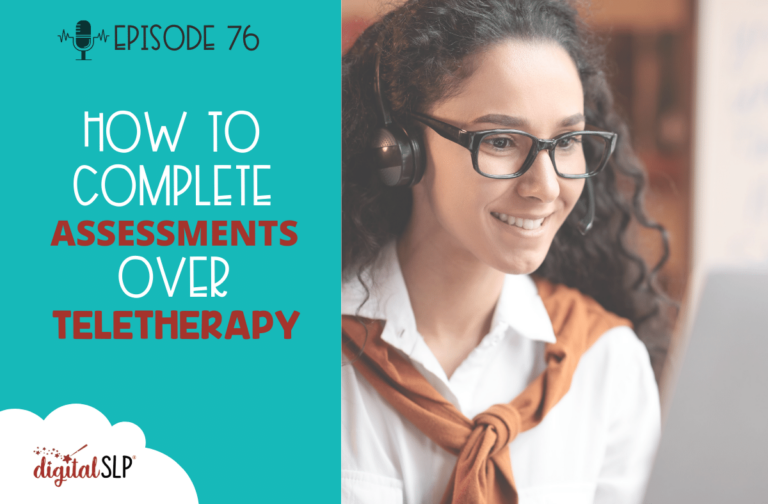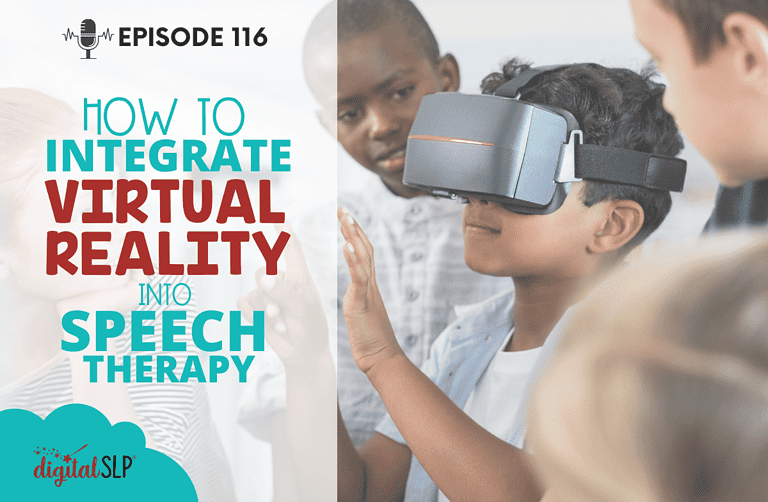Ever wonder what you need to do to prepare for teletherapy assessments to ensure they’re successful? In this episode, I will provide you with ideas on how to thoroughly assess your new patients over teletherapy. Tune in below to learn more and be sure to check out all the links and resources section at the bottom of the page!
Key points on how to complete assessments over teletherapy:
Preparing for a telehealth assessment:
- Practice administering an assessment within the telepractice environment prior to testing the child
- Guide the facilitator, or the caretaker of the child
- Ensure the child is appropriate for remote testing prior to an assessment
- Gather manipulatives and materials required for the telehealth assessment
Things to consider when you complete assessments over teletherapy:
- Examine the environment and equipment to ensure smooth assessment
- Take into account the testing needs of the child (the examinee)
- Other Considerations
Using standardized measures during telehealth assessments
Non-standardized measures such as observation, obtaining parent and teacher reports, collecting a language sample, informal speech and language testing are just as important.
Ways to capture a pointing response from the child:
- Through giving remote control access to the child to see where they are pointing
- Have the child use the annotation feature
- Have the child answer vocally, instead of pointing
- Signal or silent feedback from the parent or facilitator
Documentation of assessments:
Be specific and detailed within your documentation. For instance, take into account the quality of audio and video during the assessment, and explaining any glitches.
The podcast also discusses whether you should report the scores of a standardized assessment administered via teletherapy. In other words, it is possible to complete standardized assessments and report normative data if the conditions are right.
Links & Resources
- The Digital SLP Membership
- Pearson (digital format)
- WPS (digital format)
- Pro-Ed (digital format)
- Considerations for Teletherapy – Pearson
Full Transcript of Podcast: How to Complete Assessments Over Teletherapy
Episode 76: How to Complete Assessments Over Teletherapy
You're listening to the Speech Space Podcast, a podcast full of tips and resources for SLPs. I'm your host, Jessica Cassity, and this is Episode 76.
So today we are going to be talking about completing speech and language assessments via teletherapy. Before we get started, I did want to mention that this podcast is brought to you by The Digital SLP membership site, which is a site that features time-saving, interactive digital resources that are all teletherapy platform-friendly. If you want to learn a little bit more about that, you can head on over to thedigitalslp.com/digitalslp. All right, let's go ahead and jump right in.
So first let's go ahead and talk about preparing for a teletherapy assessment. What do you need to do in order to be sure you are all set up and ready to go for that assessment? So, number one, you want to practice administering an assessment within the telepractice environment prior to testing the child. So you really want to be sure that you're familiar on how to screen share on your computer. You want to practice giving the other computer remote mouse access, if you plan to do this during your testing. You want to ensure that you have everything you need and that all of the equipment is working properly. The more that you practice, the more prepared you're going to be during that actual testing. Now, number two is that you want to guide the facilitator or the person who's going to be sitting with the child on what to expect during the assessment. So the facilitator may be a caregiver or even a staff member within a school. So you're going to explain to them what their responsibilities are going to be during that assessment. They likely might not know what's going to happen during the assessment or even what their role might be. So you really want to provide them with details and assistance with using the technology, such as use of external cameras or any materials they may need to gather. Similar to when you complete a face-to-face evaluation and parents are present, you're going to explain to them that they cannot assist the child or prompt the child during testing, including rephrasing what the therapist says during the assessment. So that's really important to point out prior to the assessment as well. Number three, you want to be sure that the child is appropriate for remote testing prior to starting the assessment. There may be certain children who are not necessarily the most appropriate candidates for assessing via teletherapy. You're going to complete a thorough case history to determine the main concerns for the child and to help identify if assessment via teletherapy will provide you as a speech therapist with information on how to support the child's communication. Number four is that you want to make note of any manipulatives and materials that may be needed during the assessment. So you're going to gather all of those items that you need and be sure to also let the facilitator know what items they might need to collect as well. You can send that facilitator photos or you can email them ahead of time. So then they're prepared and they can gather all of the essential items as well.
Now let's go ahead and talk about things to consider while conducting a teletherapy assessment. Pearson's website lists five different areas to consider when assessing a child via teletherapy. I've gone ahead and included the link in the show notes, if you're wanting to look at that, and all the considerations that they list out in more detail. So let's go ahead and talk about some of those considerations. So one is to be sure to look at the environment and your equipment. This may include removing background noise on your end, and the child's end to create an environment free from distractions. You want to make sure that you're using a headset or earphones to support the highest quality of sound. You can also ask the facilitator to provide the child with earphones as well to enhance their audio quality. Now, remember if you're having technological difficulties, you want to go ahead and discontinue testing because that obviously is going to affect the results. Two, examinee considerations. So you want to think about testing needs of the child. Is the child young or able to sustain their attention for extended periods of time? You know, you're going to want to fit breaks into the assessment plan, games or reinforcing activities to support the child's attention. Also be sure to consider any special testing needs. For example, is the child able to physically point to pictures? If not, then you may need to adapt how you're going to be assessing that child. You also want to try to minimize any distractions during the assessment, such as other children in the household, a TV on in the background or use of phones during the assessment. So you're going to want to explain to caregivers prior to the assessment what type of environment the child should be in during the assessment to support minimizing any distractions before that assessment even begins. Some other considerations, you want to be sure that you're clear with the directions during the assessment in order to support the child's understanding along with the facilitators. You also want to provide practice items before starting the test to be sure that the child understands what is expected of them. And you also want to identify the type of assessment that you're wanting to complete, whether this be standardized or non-standardized measures.
All right, let's move on to talking about using standardized measures during telehealth assessments. When completing an assessment over telehealth, you can still complete standardized testing measures in order to obtain information regarding the child's language and communication. So just like when completing assessments face-to-face, it is always important to continue using non-standardized measures such as observation, obtaining parent and teacher reports, collecting language samples, informal speech and language testing, and collecting work samples. So you really want to make sure that you're utilizing all of those things, as well as your standardized assessment. You can complete a standardized assessment via telepractice either by using digital formats or use of paper protocols. So there are digital formats to use on a few different websites, including Pearson, Western Psychological Services (WPS), and Pro-Ed. And I will link to those websites in the show notes. You can also use the same paper protocols that you use within your face-to-face assessments by setting up a second document camera to show the stimuli to the student. Some things to consider when completing standardized measures is the way that you capture a pointing response from the child. So there are a few ways to do this, such as giving the child remote mouse control to see where they are pointing. So you can be following the little arrow of the mouse. You can also have them use the annotation feature if they're able to do that. You can have them, if it's multiple choice, name the letter or the number that corresponds to their answer instead of pointing. You could also have the facilitator set up another camera in order to capture the child's computer screen and see where they're pointing. That is less than ideal but I'm just trying to exhaust all options here because, you know, sometimes we have to adapt. The other thing that you might have is the parent or the facilitator provide a thumbs-up or thumbs-down behind the child within certain circumstances. Again, this is not necessarily best practice or ideal but sometimes this might be necessary. The child might not be able to work the mouse. They might not have a second camera to set up. So you want to make note of this in the report documentation, and explain why any of these alternative methods were used, if you did have to use them.
Now say your assessment is complete and it's time to document. Let's talk a little bit about documentation considerations. You always want to be sure to be specific and detailed within your documentation. You want to provide information on how the assessment was administered as well as detail on clinical and behavioral observations, like if the child was able to attend well during the assessment. You want to make note on the quality of the audio and the video during the assessment explaining if there were any glitches that could have made an impact on testing. If you're not using an assessment in the way that it was created to be performed, you must make note of this within your documentation as well.
The biggest question that I know everyone has on their mind is can you report the scores of a standardized assessment administered via teletherapy? And the answer is typically yes, however, it does depend. So you want to keep in mind, standardized tests are not normed for telepractice. However, some publishing companies have done research in order to show the validity of assessments given via telepractice, and how the results are similar to when being given face-to-face. So you can check the publisher websites to help you determine if a specific assessment has had this research done. Also, you know, use your clinical judgment. Take note of any factors that may occur both during telehealth assessments and face-to-face assessments, such as the child's attention during the assessment, behaviors noted, and more. So if there were several factors that you as an SLP believe impacted the data, you just want to make sure that you document these factors. You want to make sure that you do not include a blanket statement within the documentation, such as the results should be interpreted with caution as testing was completed via telepractice. You want to elaborate on this statement since this is not specific. It's also not helpful in understanding what occurred within the assessment. Instead provide details explaining if you believe it is appropriate or not appropriate to use normative scores, according to your own professional opinion. So the answer is yes, that you can complete standardized assessments and report normative data if the conditions are right. So I hope that using all of this information, you feel more prepared now while completing assessments in telehealth appointments.
I am not sure if my podcast editor is going to be able to edit it out but there is a thunderstorm here right now. So if you heard some booms in the background, that is what you're hearing. Now like I mentioned at the beginning of the show, the doors to the membership are open. So if you are looking for a collection of teletherapy platform- friendly resources, then head on over to thedigitalslp.com/digitalslp. And if you would like to access the show notes for today's episode, please head on over to bitly.com/TSSEP76. All right. I hope that you guys have a wonderful week, and I will catch up with you again in a couple more weeks.













Recent Comments